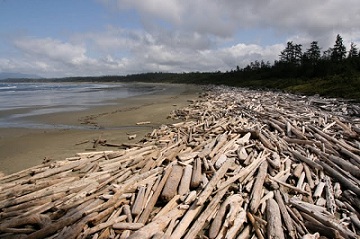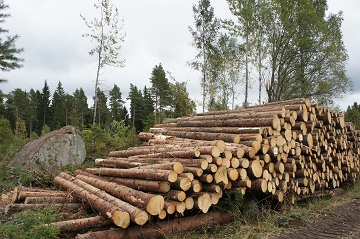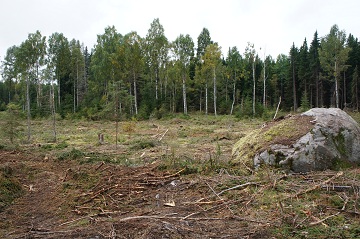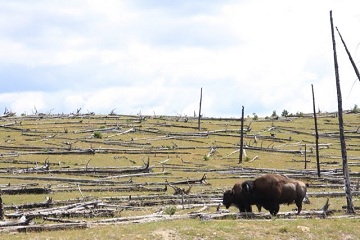- Disturbance-based ecosystem management -
It is beginning to be accepted that in order to preserve ecological integrity and biodiversity there must be an appreciation for the instability and randomness of natural disturbances (Mori 2011b). As forest is a primary component of terrestrial landscapes, it is of utmost importance that several ecological considerations are made, which include the hierarchical disturbance regime, multiple-post-disturbance pathways, climate instability, spatial and temporal variability, and resilience (Mori 2011b). That is to say that terrestrial landscapes are prone to large environmental changes and diverse disturbances, and thus, are dynamic and non-equilibrating (Phillips 2004; Moore et al. 2009; Mori 2011). Armed with this information it could be possible to maintain natural diversity at many levels of an ecosystem, such as genes, spices, organisms, communities, and regional landscape. Based on the natural disturbances of the ecosystem and scientific knowledge of forestry dynamics the goal is to improve the conservation and management of forests. Strictly speaking the objective is to encourage forest management policy to respect the ever changing nature of forests and by this contribute to conserving biodiversity and ecological processes at all levels of the forest ecosystem.






Natural disturbances, such as fire, drought, storm, and insect outbreak, are necessary and inevitable events, and the biota has been living in these conditions for millions of years. With this amount of exposure the biota has evolved to cope with such natural disturbances. Some humans on the other hand recognize these natural disturbances, especially massive ones, like earthquakes or forest fires as disasters for our society. For this reason, the thought was to try and exclude these natural disturbances from occurring at all. As a result in some ecosystems, this elimination of natural disturbance has led to the loss of a healthy dynamic ecosystem (Layzer 2008; Gunderson et al. 2009; Mori 2011a).
Furthermore, anthropogenic disturbances, such as deforestation, also have a huge impact on forest ecosystems. This is because anthropogenic disturbances can reduce resilience of ecosystems, which is the ability to resist to and recover from environmental perturbations. Therefore if the effects of natural disturbances are mimicked during forest harvest for example it may be possible to decrease the negative impact on ecosystems. As a matter of fact this idea is being incorporated in many production forests around the world. Respecting natural dynamics is essential in maintaining sustainable recourses from the viewpoint of ecosystem-based management (Mori 2011b).
Now it is worth focusing on a matrix management. The matrix is defined as areas in a landscape that conserving biodiversity, ecological processes, and natural ecosystems is not a primary objective (Lindenmayer & Franklin 2002). In other words, the matrix is not pristine nature, but could be an agricultural farmland or a plantation forest landscape. Now it is believed that even in a matrix, it is quite important to pay attention to nature conservation (so called as "matrix management").
There is a new form of resource management arising from this knowledge. In the past we have focused on the maximum resource yield, but now the ecosystem-based management is challenging to meet the socio-economic, political and cultural needs of current and future generations. This new system requires attention in various ecological services including, climate regulation (regulating services), nutrient cycle (supporting services) and recreational experience (cultural services), which human society receive from healthy ecosystems. Ecological dynamics generated by natural disturbances are especially one of the most important aspects to sustain ecological integrity and biological diversity (Mori 2011b). Therefore, when it comes to sustainability in the context of ecosystem-based management, it is necessary to respect natural disturbance regime of the systems (Mori 2011b).

References
Gunderson LH et al. (2009) Foundation of Ecological Resilience. Island Press, Washington D.C., USA.
Layzer (2008) Natural experiments. Ecosystem-based management and the environment. MIT Press, Cambridge, USA.
Lindenmayer & Franklin (2002) Conserving forest biodiversity. A comprehensive multiscaled approach. Island Press, Washington, DC, USA.
Mori AS (2011b) Ecosystem management based on natural disturbances: Hierarchical context and non-equilibrium paradigm. Journal of Applied Ecology 48: 280-292.
Mori AS (2011a) Making society more resilient. Nature 284: 474.
Moore SA et al. (2009) Diversity in current ecological thinking: implications for environmental management. Environmental Management 43: 17-27.
Phillips, JD (2004) Divergence, sensitivity, and nonequilibrium in ecosystems. Geographical Analysis 36, 369-383.